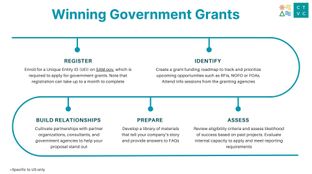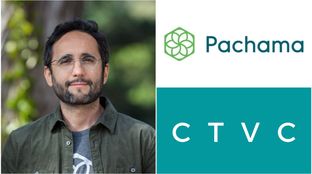
🌎 Get ready with me: Government grants edition 💅💵
A founder’s guide to winning non-dilutive funding with Elemental Excelerator
We chatted with Kathy Hannun (President & Co-founder) and Michael Sachse (CEO) of Dandelion Energy about how they turned a moonshot idea for geothermal heating and cooling into the most recent company to be backed by Breakthrough Energy Ventures.

We chatted with Kathy Hannun (President & Co-founder) and Michael Sachse (CEO) of Dandelion Energy about how they turned a moonshot idea for geothermal heating and cooling into the most recent company to be backed by Breakthrough Energy Ventures. With 500+ home installations to date, Dandelion is powering grid resiliency by bringing geothermal to people’s backyards.
What led you to start Dandelion Energy?
Dandelion started when I (Kathy) was at Alphabet’s innovation lab, X, and hunting for moonshot opportunities to apply mission-aligned technology to big problems in the energy space. Before landing on the idea that became Dandelion, I had been working on Project Foghorn – a new production mechanism to produce carbon neutral methanol by combining seawater and renewable hydrogen. It worked, but ultimately the risk profile and costs were too high to build a business from it. Coming out of that project, I was looking for a commercialization-ready technology where costs made sense – geothermal checked those boxes.
Like most people, I didn’t know too much about geothermal at first, but the large fraction of energy used to power consumers’ homes caught my attention – it’s right up there with transportation. All of this attention is directed towards electrifying transportation, while very little time or effort is going into electrifying heating.
How did Dandelion go from a project at X to a standalone company?
Prior to Dandelion, very few startups had spun out of X, so there wasn’t really a blueprint to follow. We quickly realized that Dandelion was better suited to be a standalone company versus an Alphabet-internal division given the nature of the product and need to iterate and improve quickly by going to market. We were eager to install systems in homeowners’ yards across upstate New York. We also didn’t need as much upfront capital as other Alphabet companies like self-driving cars to get started.
After spinning Dandelion out of X and growing the business for about 3 years, I brought in Michael who had previously run OPower and been an entrepreneur in residence at NEA. My passion is in R&D, while Michael’s unique skill set is in complex operations – so it’s been a really great fit so far.
Why have geothermal and home heating largely been overlooked?
Furnaces and boilers are hidden in our basements or attics so they tend to be out of sight and out of mind. Every building is also slightly different which makes it challenging to build a product that’s scalable in such a heterogeneous environment. First solar took off and has since become mainstream. Now we’re in the age of the electric vehicle transition. Buildings are primed as the next major segment to electrify.
So what does Dandelion Energy do?
Dandelion installs geothermal heating and cooling systems in homes. We make geothermal heating and cooling affordable and widely available. Our homeowners in the Northeast used to burn propane, fuel oil, or natural gas in their boilers for heat. By switching to geothermal, they save money on heating and cooling – and switch to an emissions-free system. We put ground loops in their yard, connect them to a heat pump where their furnace used to be, and then our customers have a renewable heating and cooling solution – which also provides half of their hot water.
What is the climate impact of switching from home heating with oil to heating with geothermal?
In order for Breakthrough Energy Ventures to invest, a company must demonstrate the potential to remove at least 500 megatons of carbon each year. Our eyes are on that goal. Simply put, for anyone living in the Northeast’s colder climate, switching to geothermal home heating is the single most significant thing that you can do to reduce your carbon footprint.
How are the benefits and challenges of geothermal versus other renewable heating and cooling solutions?
When it comes to heating and cooling systems, there are three choices:
Before Dandelion, there had been little thought put into a residential geothermal product. How to install ground loops and connect them to a heat pump inside the home? How to design an easy and convenient customer experience? That’s what we’ve been working hard to solve and prove to our customers.
How does Dandelion’s technology work?
We’re different from other geothermal players in a few ways. We first started experimenting with methods of ground loop installation that’re appropriate for a residential setting. In the past, water well rigs were appropriated to install ground loops. That, or you’d literally bring in an excavator to dig a big swimming pool-sized hole in the ground, complete with all of the noise, mud, and chaos. Dandelion’s target customers are suburban homeowners with nice yards where these methods don’t work. We’ve created a small modular drill for our low impact process that’s custom built for residential geothermal. Our suite of equipment is designed to work across different geologies, while being confined to tight installation areas. It takes just a few people to operate the process which helps keep costs low for the homeowner.
The next thing is the heat pump itself. Geothermal has historically been a niche luxury market, so heat pumps haven’t been designed as a mainstream product. Our scale means that we’ve created a higher-value heat pump that has full monitoring capabilities as well.
And finally, we’ve made the customer experience much simpler. We manage the project end to end with a dedicated account manager. Homeowners are abstracted from the complexity of the install and don’t have to worry about any of the legwork to ensure their geothermal system works.
What is Dandelion’s proprietary technology?
Our tech stack has three core areas. The first is data insights. We leverage a lot of information to understand how to size geothermal systems: what’s going on under the soil, how the heat exchange is working, and can accurately design systems with that data.
The second piece of the puzzle is our proprietary heat pump. Heat pumps themselves are fairly simple pieces of machinery, but we’ve designed ours with a data-driven approach which helps us improve future iterations.
The last critical piece of the stack is our customer network and demand which justifies creating a residential-specific drilling model.
Who are your target customers and what are the home requirements for residential geothermal? What does the installation and onboarding look like?
The typical Dandelion customer owns a freestanding suburban home that’s typically heated with fuel oil or propane. They’re motivated by cost savings, are adopters of new technology, and – secondarily – care about climate.
The installation process can be broken into three parts: 2-3 days to drill the boreholes, 1 day to trench or connect the boreholes to the home, and 1-2 days to install the heat pump. Meanwhile, the customer’s existing heating and cooling system isn’t affected, so they can keep on living in their home during the installation. Any disruption is for all of a few hours.
What does your customer traction look like so far?
Since we spun out of X, we’ve installed in over 500 homes, with about half of that volume just last year. In the near term, we’re planning on serving many more hundreds and thousands of homes.
What does the market for residential geothermal look like today? How do you see the residential geothermal market playing out in comparison to residential solar?
The market we’re focused on is homes using fuel oil or propane. Across New York, Connecticut, and Massachusetts there are 2.6 million homes that fall in this category. Bring in the rest of New England, Pennsylvania, New Jersey, and that number rises to 5.6 million homes. That’s our initial starting market – and it’s quite large, especially given our capacity to serve 10,000 homes per year.
The broader trend here is that natural gas’ days are numbered. The CEO of ConEd has even said publicly that they don’t intend to invest in natural gas assets going forward. There will be fewer connections to the natural gas grid, and in tandem we’ll get better at offering lower-priced products that can compete standalone with natural gas. We’re experimenting with increasing the efficiency of the heat exchange down the hole, which would dramatically reduce the major cost of drilling. We’re also investing in improving our heat pump hardware and lowering the installation costs to be able to service more homes.
How does financing for residential geothermal work? How does it compare to the residential solar leasing model?
We provide financing for our customers which means that from day one they see a lower energy bill. We’re really focusing on improving financing options, and will get better as we build up more proof points in this market. The solar industry has done a really good job of creative financing and bringing this cost down for customers. We’re actively looking at the solar leasing model and exploring how to replicate that in geothermal. It will be an iterative process where we bring proposed models to potential funders and work off their feedback. There’s also a legal component that we have to define in geothermal – a solar company can reclaim their panels if the homeowner doesn’t pay – but obviously it’s more challenging to reclaim a heat pump or ground loops.
Texas’s non-resilient grid has been at the top of the news. How are you thinking about residential geothermal’s geographical expansion?
Our primary go to market path is through new homes. Lennar, the US homebuilding giant, is strategically an investor in Dandelion. We’re very interested in exploring geothermal’s fit with other cold weather communities. The Texas situation has demonstrated that we need to build a larger, more resilient grid; using less energy is a huge part of that. Geothermal is fundamentally an energy efficiency technology because it decreases the amount of energy necessary to heat or cool the home.
Heat pumps might just be the next LED light bulb. What are your thoughts on the climate significance of heat pumps?
We need to electrify. In order to do that, heat pumps need to be better and cheaper. At Dandelion, we see ground source heat pumps as a vital part of that transition – it’s something we’re really excited about. Ground source and air source heat pumps are close cousins. If we’re successful with ground source, we hope to contribute to making air source heat pumps better and less expensive as well.
You just raised a $30m Series B round led by Breakthrough Energy Ventures. Congratulations! What does the future look like for Dandelion?
We’re thrilled that BEV, Bill Gates’ climate fund, led our Series B and that all of our prior investors participated. Our plan is to begin expanding geographically – into Long Island, further in Connecticut and Massachusetts – and to really double down on our R&D. With our fast pace of growth, we’ve been caught up in meeting customer expectations. With this funding, we’ve reached a scale where we can separate our long-term product vision from servicing customers day-to-day. We’ve got a lot of experiments we want to run, and have been waiting for the capacity to do it.
Curious about how you or a friend with property in the Northeast can switch to geothermal? Head to Dandelion’s website to see if your home qualifies. Likewise, the company is always looking for drillers to join the team – or, one better, water well drilling companies in the Northeast. If you hold the magic ticket, email us right away!

A founder’s guide to winning non-dilutive funding with Elemental Excelerator

Infrastructure investing for impact with Banyan Infrastructure's Amanda Li

Venturing into nature with Diego Saez-Gil at Pachama